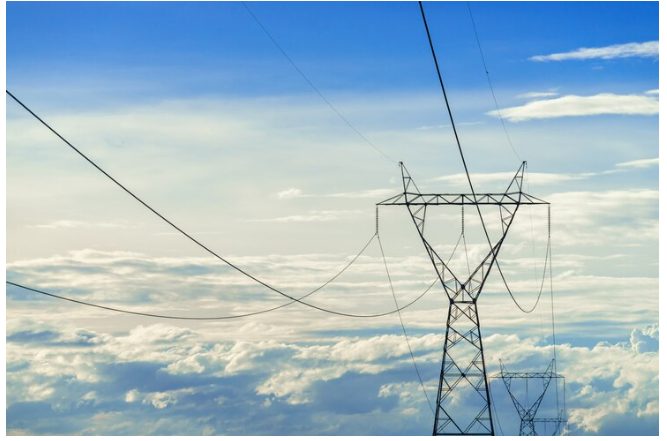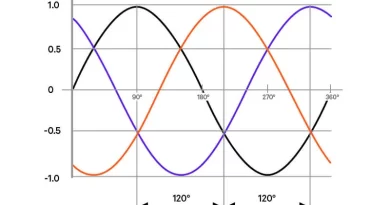When and Why is DC used for long-distance Electric Power lines instead of AC?
When and why is Direct Current used for long-distance electric power lines instead of AC?
Introduction
For most power transmission applications, alternating current (AC) carried on overhead high-voltage lines is the predominant technology. However, high-voltage direct current (HVDC) proves more practical and economical for some long-distance electric transmission links. In this article, we’ll look at when HVDC is the preferred choice over AC and what unique advantages HVDC provides for long-haul power transmission.

Advantages of AC power transmission
First, let’s review why AC is the primary method for electric power transmission:
Easy voltage conversion
With AC, transformers allow voltage levels to be easily increased or decreased. This enables efficient long-distance transmission.
Lower line losses
High-voltage AC has lower resistive losses compared to an equivalent DC line. The AC current also uses all the conductor material evenly.
Benefits of HVDC transmission
In some cases, HVDC has advantages over AC:
Lower costs over very long distances
Over distances of hundreds of miles, the converter stations needed for HVDC become less costly than the capacitors and inductors required to transmit AC.
Asynchronous grid interconnections
HVDC allows connecting grids operating at differing frequencies or phases since only DC flows between the grids.
Underwater and underground lines
HVDC avoids the higher charging current losses associated with underwater or underground AC cable runs.
HVDC transmission technology
The components enabling HVDC transmission include:
Converter stations
These convert between AC and DC with thyristor or transistor-based inverters and rectifiers.
Overhead and underground cables
HVDC lines use specially insulated cables with laminated poles for overhead lines and polymeric-insulated wires buried underground or underwater.
Control systems
Equipment monitors and adjusts DC voltage and power flow to ensure stable operation.
HVDC applications and projects
Typical HVDC uses:
Cross-country and subsea links
HVDC efficiently connects load centers separated by great distances across land areas or spanning bodies of water.
Connecting remote power sources
It allows distant energy sources like hydroelectric dams or wind farms to transmit power to faraway cities.
Strengthening urban networks
HVDC ties between urban substations can add grid capacity and stability.
Conclusion
In summary, while AC dominates electrical transmission, HVDC fills a vital niche application for efficiently transmitting large amounts of power over long hauls of hundreds of miles. The economic break-even distance where HVDC becomes worthwhile decreases as technology matures. This makes HVDC an increasingly attractive option for linking distant power grids and sources.
The choice between AC and DC for long-distance power lines depends on various factors, including distance, economics, and environmental considerations. While AC remains the standard for local distribution, DC, especially HVDC lines, plays a crucial role in efficiently transmitting power over extended distances.
Frequently Asked Questions (FAQs)
Q1: What’s the main advantage of using DC over AC for long-distance power lines?
A1: The main advantage of using DC (Direct Current) over AC (Alternating Current) for long-distance power lines is reduced energy loss during transmission. DC lines, known as High-Voltage Direct Current (HVDC) lines, experience significantly less resistance and power loss, making them more efficient for transmitting electricity over extended distances.
Q2: Are there specific industries that benefit more from HVDC transmission?
A2: HVDC transmission is particularly beneficial for industries transmitting power over long distances or across challenging geographical terrains. Initiatives such as renewable energy, interconnecting power grids between countries, and supplying remote areas with electricity benefit greatly from the efficiency of HVDC technology.
Q3: Does using DC for power transmission impact the quality of electricity delivered to homes and businesses?
A3: DC for long-distance power transmission typically does not impact the quality of electricity delivered to homes and businesses. HVDC technology is designed to convert DC power back to AC at the receiving end, ensuring that the electricity supplied to end-users is the same quality as traditional AC power.
Q4: Are HVDC lines more reliable than traditional AC power lines?
A4: HVDC lines are generally considered reliable for long-distance power transmission. They have a lower risk of voltage drop and power loss over extended distances, making them dependable for transmitting electricity over challenging terrains or borders. However, like any infrastructure, HVDC lines require proper maintenance to ensure reliability.
Q5: Can existing AC grids be easily converted to accommodate HVDC transmission?
A5: Converting existing AC grids to accommodate HVDC transmission can be complex and costly. It often involves the installation of HVDC converter stations and modifying the existing infrastructure. The feasibility and ease of conversion depend on the specific grid and project requirements.
Q6: Are there any environmental downsides to HVDC transmission?
A6: HVDC transmission can have environmental benefits. Reducing power loss during transmission minimizes the need for additional power generation, which can reduce greenhouse gas emissions and environmental impact. However, the ecological impact of HVDC projects can vary depending on location and construction practices.
Q7: How do HVDC converter stations work, and where are they typically located?
A7: HVDC converter stations are critical components of HVDC transmission systems. They convert AC power to DC at the sending end and DC back to AC at the receiving end. Converter stations are typically located near the points where power enters or exits the HVDC transmission system, which can be at substations or strategic locations along the transmission route.
Q8: Are there ongoing developments in HVDC technology that could improve efficiency?
A8: Yes, ongoing developments in HVDC technology aim to enhance efficiency and reliability. Advances in converter technology, grid integration, and control systems continue to improve the performance of HVDC transmission. Researchers are also exploring ways to make HVDC systems more cost-effective and adaptable to various applications.
Q9: Can HVDC lines transmit renewable energy more efficiently than AC lines?
A9: Yes, HVDC lines are well-suited for transmitting renewable energy from remote areas with abundant renewable resources, such as wind or solar farms. HVDC transmission reduces power loss during long-distance transport, making it an efficient choice for connecting renewable energy sources to the grid and delivering clean energy to distant regions.
Q10: Are there any safety considerations unique to HVDC transmission?
A10: HVDC transmission systems have specific safety considerations for high-voltage DC power. Safety measures include implementing proper insulation, ensuring secure grounding, and following safety protocols during maintenance and operation. Safety standards and regulations govern the construction and operation of HVDC projects to mitigate risks.
MCQs
What are the main components of an HVDC system?
Major components are the converter stations with thyristors/transistors, smoothing reactors, harmonic filters, overhead lines or underground/submarine cables, cooling systems, and control/protection equipment.
How does HVDC help stabilize AC transmission grids?
It provides controllable flows between points on a grid that help regulate voltages and increase transmission capacity and reliability. This improves grid stability.
What are some standard HVDC converter station configurations?
Common arrangements are back-to-back stations, two-terminal links, and multi-terminal systems with several tap points.
What are the disadvantages of using HVDC transmission?
Drawbacks include higher conversion costs, costly synchronous condensers, vulnerability to commutation failures, and complexity requiring highly trained staff.
How much lower are transmission losses with HVDC versus AC?
Typical HVDC losses are around 3% per 1,000 km, compared to AC losses of 9% over the same distance. The difference is especially significant for underground/undersea cables.
What environmental benefits does HVDC provide?
It has a more compact right-of-way, reduces high voltage corona losses, emits less EMI, and is less susceptible to contributing to atmospheric contamination compared to AC.
What is reactive power compensation needed for HVDC systems? Reactive power is consumed only by the converter stations. Compensating capacitors supply this reactive demand.
What types of cables are used for HVDC subsea links?
Cables have cross-linked polyethylene or ethylene propylene rubber insulation in either mass-impregnated or layered designs to withstand high DC voltage underwater.
Where was the first installed HVDC project?
The first commercial HVDC system connected the Swedish mainland with the island of Gotland in 1954. It demonstrated the feasibility of HVDC technology.
How much power can modern HVDC lines transmit?
HVDC line capacities now reach 10 GW and beyond. Capacities continue to advance with improvements in power electronics devices and control methods.





I’m not sure who this article is suited for. Not for me, because I already knew the major features and I’m more interested in concrete facts, like numbers. For instance, over how many hundred miles does HVDC become more efficient? In many areas, there isn’t enough detail. For instance, what’s all that underwater stuff? No details whatsoever, and it makes me wonder if the writer is really a knowledgeable engineer.